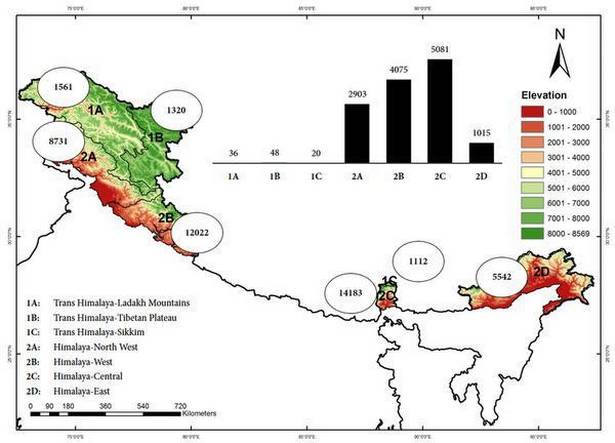The Indian Himalayas, which constitute about 12% of the country’s landmass, is home to about 30.16% of its fauna, says a new publication from the Zoological Survey of India (ZSI).
The publication, Faunal Diversity of Indian Himalaya, lists 30,377 species/subspecies in the region with the entire identified fauna in the country adding up to 1,00,762.
Spread across six States — from Jammu and Kashmir in the west through Himachal Pradesh, Uttarakhand, Sikkim and West Bengal’s Darjeeling to Arunachal Pradesh in the far east —the Indian Himalayas are divided into two bio-geographic zones — the Trans-Himalaya and the Himalaya, based on physiographic, climatic and eco-biological attributes.
Pit viper
Abundance of species
The entire region, spread over 3.95 lakh sq. km., is home to 280 species of mammals, 940 species of birds, 316 species of fishes, 200 species of reptiles and 80 species of amphibians. This put together accounts for 27.6% of the total vertebrate diversity of the country.
The central Himalayas are the most rich in faunal diversity with 14,183 species, followed by the west Himalayas, which is home to 12,022 species.
Dr. Kailash Chandra, Director of ZSI, one of the authors of the publication, said no other geographic region in the country is as unique and influences the ecology and bio-geography of the country as the Indian Himalayas.
Black-necked Crane (Grus nigricollis) seen near Rhongo village Ladakh
Extensive collaboration
According to Dr. Chandra, 85 taxonomic experts and specialists of various groups of faunal groups actively collaborated and contributed more than 50 chapters on the organisms, their habitats and the threats facing them.
In addition to Dr. Chandra, the publication has been co-authored by K.C. Gopi, Devanshu Gupta, Bausudev Tripathi and Vikas Kumar.
Measuring the range of species spread over the biotic provinces of the vast Indian Himalayan land mass, the authors aimed to identify areas for future research.
Dr. Chandra said the fauna of the region exhibited an intermingling of both the Oriental and Palaearctic-Ethiopian elements. He explained that the eastern parts of the Indian Himalayas, a bio-diversity hotspot, had tropical elements with their affinities from Indo-Chinese and Malayan sub-regions of the Oriental region. The fauna of the western part of the Indian Himalayas on the other hand, comprises the Mediterranean and Ethiopian elements.
The Indian Himalayas also have 131 protected areas, which cover 9.6% of the entire protected area of the country, almost the same as the Western Ghats (10% of protected areas), another biodiversity hotspot in the country. The protected areas include 20 national parks, 71 wildlife sanctuaries, five tiger reserves, four biosphere reserves and seven Ramsar Wetland sites.
The publication lists 133 vertebrate species of the region cited as threatened in the IUCN Red List. This includes 43 species of mammals like the critically endangered Pygmy Hog, the Namdapha flying squirrel and the endangered Snow leopard, the Red Panda and the Kashmir Gray Langur.
Fifty-two species of birds are also in the threatened category like the critically endangered White-Bellied Heron and Siberian crane and vulnerable species like the Black Necked crane and the Indian Spotted eagle, among others. Of the 940 bird species found in the Indian Himalayas, 39 are endemic to the region.
The Indian Himalayas host 1,249 species/subspecies of butterflies, with the highest density recorded in Arunachal Pradesh. Some of the rare high-altitude butterflies found in the Himalayas are Parnassius stoliczkanus (Ladakh banded Apollo) and Parnassius epaphus (Red Apollo), listed under Schedule I and Schedule II of the Wildlife Protection Act, 1972, respectively.
Role of climate change
According to experts, most of the threatened species of vertebrates, particularly mammals, require population assessment and study of the role of climate change on their habitat.
Climate change is the major threat as far as mammals and birds are concerned. The impact is visible in the shifting distribution of sensitive species like the Asiatic Black Bear, the Snow leopard, and the Himalayan Marmot. “Carnivores and their habitats are threatened by ever-increasing human-wildlife conflict in the region,” the publication states.
Habitat loss due to land use change, illegal wildlife trade, forest fires and increasing anthropogenic activities pose threats to this Himayalan biodiversity, the publication underlines.
by Shiv Sahay Singh

